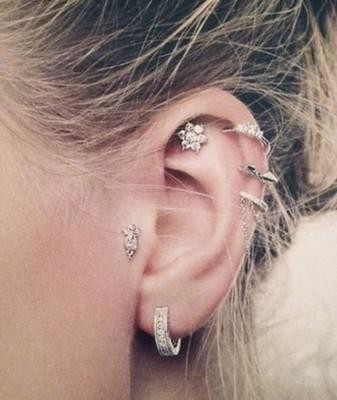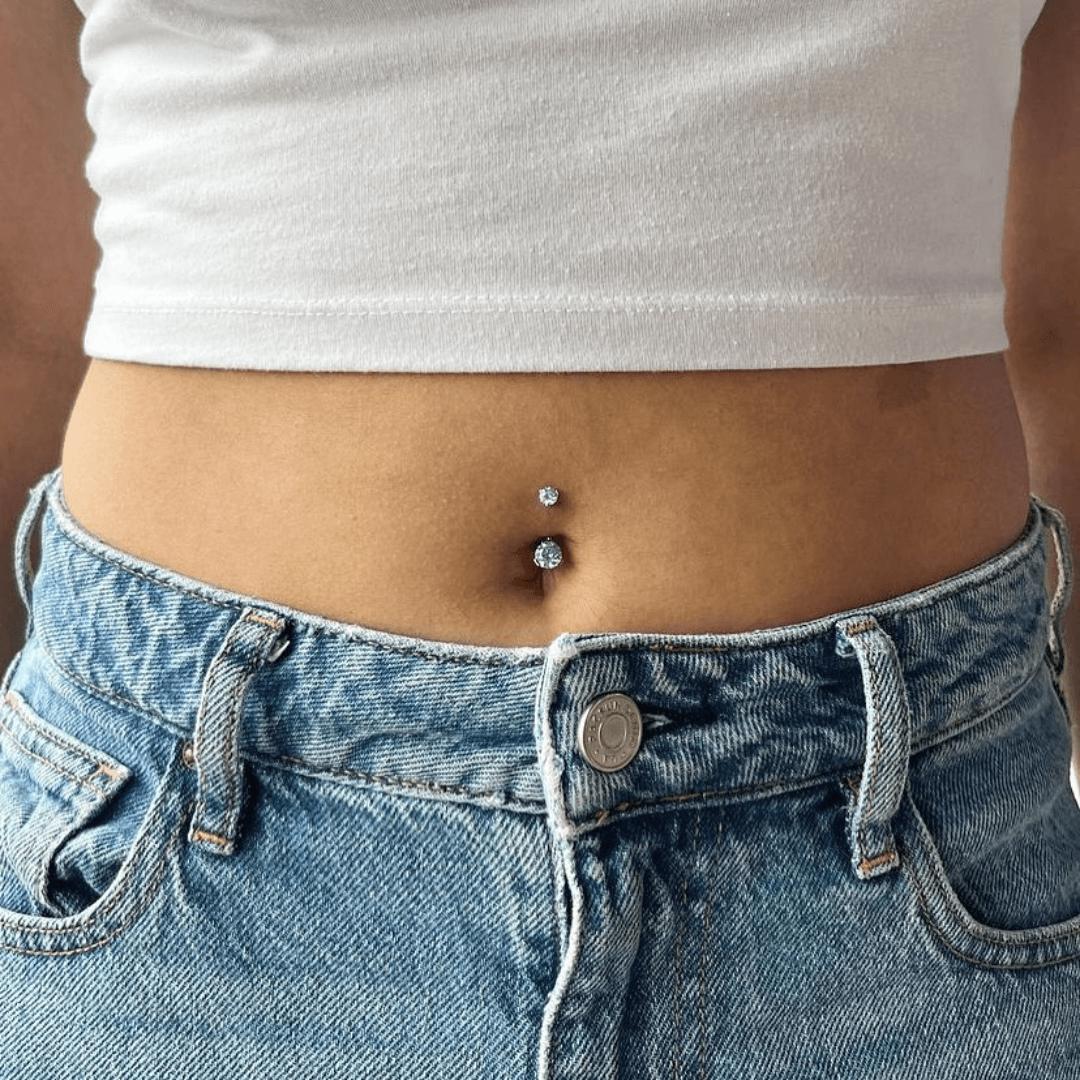
Piercings
Our piercing services offer a safe and stylish way to express your individuality. With a focus on hygiene and comfort, our experienced professionals provide a range of piercings, from ears to body, using high-quality materials.

Ear

Face

Body
Age and ID Requirement in Wisconsin
In the State of Wisconsin, you must be at least 16 years old to get a BODY piercing.
The House of Creations policy is we pierce no one under 5 (lobes) and no one under 10 (cartilage). If you are under 18 you must have a parent or legal guardian sign a consent form. Picture ID for both the minor and parent or guardian must be provided and if the minor does not have a photo ID, a birth certificate is fine.
Anyone requesting a body piercing must provide a photo ID. Handwritten letters/notes, emails, text messages, or phone calls, will not be accepted.
Piercing FAQ, Healing & Aftercare
Let's talk piercing pain...
Your first piercing can be scary. It's totally okay to be nervous. There is a needle going into your skin; so it's probably going to hurt, correct? There are so many questions that go through our heads the first time e get a piercing.
How bad is it going to hurt?
What if it doesn't heal?
Will it look good on me?
These questions and feelings you get can absolutely detour someone from going through ith a piercing. Let's clear up your concerns about pain.
Rule of thumb...
– earlobe, navel, tongue, and eyebrow piercings are the least painful.
– labret, dermal (surface piercings), cartilage, and nostril piercings are typically a medium-level pain for most people.
A piercing will follow a normal and predictable progression from a new wound to a healed piercing. During this time the flesh tunnel or fistula that was made during the piercing and into which jewelry was inserted will form, heal and toughen or mature.
The following stages are not separate but overlap at times and maybe happening at the same time.
The normal stages of healing are:
• Inflammation
• Epithelialization
• Angiogenesis
• Maturation
Inflammation
Inflammation is the body's response to harmful stimuli such as damaged cells caused by the piercing. Afte the initial piercing chemicals are released from the damaged tissue cells triggering the inflammatory response. The body uses inflammation to protect the pricing and initiate the healing process of the tissue. The piercing may be swollen, red, and tender. This is all good and normal.
Epitheliazation and Angiogenesis (known as Proliferation Phase)
Epitheliazation is the next step in the healing process. This occurs when the body creates new epithelium (or be skin) after playing down new basal cells. The epithelium cells start to grow from the edges of the piercing inward and eventually grow together and mature. completely lining the piercing forming the fistula. You may notice a "scab" growing over the wound during the process. Leave this intact, it protect s the piercing.
Maturation
The last phase in the new wound healing process is the maturation or remodeling of the skin cells. Usually, when this process occurs, the wound will be completely healed, but with a piercing that has jewelry in it, it may take longer than a normal wound to toughen up and may even revert to an earlier stage of healing if traumatized. Some piercings may take several months to toughen up and truly be healed. A good sign of a healed piercing is that it is no longer red or tender and no longer has crust-forming secretions, the edges will be smooth and not ragged. Because of the nature of the piercings, being a hole in your body, there was always be exudate present that is made up of cellular waste and keratin, it protects and lubricates and is malodorous (smells bad).
Since there are so many different types of piercings and many different degrees of trauma involved, the rate in which a piercing heals varies.
Appropriate aftercare is extremely important for the body to heal itself naturally. Make sure you are properly caring for your piercing until the wound has completely healed.
Keep the piercing clean and protect it from injury. If you have a wound that is not healing properly consult your piercer first because they can give you advice on what steps are needed in order to speed the healing process.
Healthy and effective aftercare is incredibly important when it comes to any fresh piercing. A new piercing that has taken care of will heal faster. prevent unforeseen problems, and will help you enjoy your piercing to the fullest.
An important and very common suggestion for aftercare is the of saline or salt water. Why is salt an effective cleanser? Do different types of salt have different levels of effectiveness? How often should I be soaking my piercings?
From belly button rings to your nose rings, Body Candy is here to help you make smart and informed decisions when it comes to your aftercare needs!
First and foremost, it is helpful to understand that every body is different! While there is no universal aftercare solution that will work for every single person in every situation, salt soaks are one of the most common and effective ways to treat a piercing.
When your skin is wounded salt deposits in your body help to activate cells that fight off infection, soaking your fresh piercing in saline will deliver therapeutic amounts of salt to the wound, which helps aid in the overall healing process. These soaks can flush out any discharge or debris that may slow the healing process. A warm salt soak can help to soothe the pesky itches and irritations that come along with fresh piercing. It also helps promote much-needed circulation to the wound.
Getting a piercing can be quite an experience – some individuals might even think it's fun or therapeutic... BUT it's often what happens AFTER the piercing procedure that is most important. Nobody wants to experience soreness, an infection, or rejection, and you might think that you should treat your new piercing like any other wound and use a spray or topical cream.
In actuality, there are several products that you should AVOID putting on your piercings. We've compiled them below.
1. Alcohol
2. Hydrogen Peroxide
3. Betadine, Bactine, or anything containing Triclosan
4. Petroleum Jelly
5. Tea Tree Oil
Boil, Keloid or a hypertrophic scar, nobody really cares what they are called, they just want to get rid of it. Identifying the bump(s) you have is key in doing that. The generic term " keloid" has been used to describe these bump, but really they may be of three types.
Most of us who have piercings have had that moment; you find a lump or a bump on your fresh new piercing that looked fine just a day or two ago. You panic, wondering, "What is that? Do I need a doctor? Do I need to take my new jewelry out?
The House of Creations is only here to give you helpful advice when it comes to healing your piercing. If you think there is a medical issue, contact us and/or your doctor ASAP.
Sea Salt Soak
Use Pure Sea Salt (non-iodized) and Distilled or Boiled Water ONLY!
1/4 teaspoon of Sea Salt + 1 Cup / 8 oz. of Distilled Water
1 teaspoon of Sea Salt + 1 Quart / 32 oz. of Distilled Water
4 teaspoons of Sea Salt + 1 Gallon of Distilled Water
1/4 Cup of Sea Salt + Full Bathtub of Distilled Water
2 gentle soaks per day helps keep infection away!
What to look for in a Piercing Salon...
This is the first thing you should check before allowing anyone at a studio to pierce your body. However, a license does not mean that the piercer is properly trained to perform your piercing properly. Some areas have established requirements for piercing studio locations to receive a license to operate whereas other areas only require a fee to be paid in order to gain a permit.
This is perhaps the most important aspect to be. sure of before letting anyone pierce you. You don't want any complications if you prevent them. There should be a specific room or area designated for piercings. There should be an area to sterilize the equipment or tools. Both the area and staff should be noticeably clean.
Also, know as a sterilizer, the autoclave is a piece of sanitizing equipment that every piercer should have in their studio to make sure the jewelry and equipment that is being used safe and clean for you. In fact, a studio should not be in operation if they do not own an autoclave sterilizer.
Spore tests prove that autoclave equipment is working correctly. They will test the autoclave's ability to kill dangerous organisms and viruses. Also known as biological indicators, the results of the tests should clearly state "pass" – and the piercer should be happy to show them to you.
Are there example piercings they have performed previously healthy and well placed? You wouldn't get a tattoo without seeing the artist's work, right? Why would you let anyone pierce you if you without seeing their previously performed piercings? Healed photos of healed piercings are also indicators of a professional piercer
If they do, they're doing the correct thing. Every reputable piercer should inform you of the proper aftercare procedures to make sure that you and your piercing have a hassle-free healing process. Not only should they verbally address only address care instructions; your piercer should also provide you with a written handout explaining the information for your reference.
Don't be impulsive without being informed. If a price seems too low to be true, it probably means that you're not working with a professional piercer. You get what you pay for, so make sure you trust your instincts. Oh, and if you see a piercing gun– run away!

